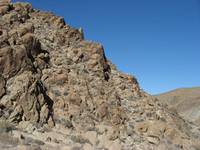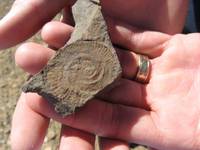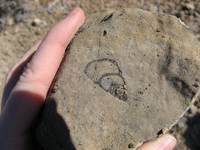January 5th, 2009 at 11:53 pm (Animals, Geology)
 So again, on Sunday, I drove out to explore Amboy Crater (also see wikipedia’s article). It is a fairly recent cinder cone caused by volcanic activity out in the desert between 6000 and 500 (yes, only 500!) years ago. Once you get to the parking lot (about a 3-hour drive from here, not exactly my backyard), it’s a 2-hour round-trip hike to the crater, up to the rim (250 feet high), and back down and out. You get some spectacular views from the top of the desert and the huge lava field created by the cinder cone. I’d show you some views captured by me, except that I somehow left my camera at home (with my whole daypack, including lunch, extra water, batteries, etc.). I realized this just past Barstow (halfway to Amboy) and it wasn’t worth going back. Instead, I’ll just link to other people’s photos! (Photo at right is from Golden Gate Photo.)
So again, on Sunday, I drove out to explore Amboy Crater (also see wikipedia’s article). It is a fairly recent cinder cone caused by volcanic activity out in the desert between 6000 and 500 (yes, only 500!) years ago. Once you get to the parking lot (about a 3-hour drive from here, not exactly my backyard), it’s a 2-hour round-trip hike to the crater, up to the rim (250 feet high), and back down and out. You get some spectacular views from the top of the desert and the huge lava field created by the cinder cone. I’d show you some views captured by me, except that I somehow left my camera at home (with my whole daypack, including lunch, extra water, batteries, etc.). I realized this just past Barstow (halfway to Amboy) and it wasn’t worth going back. Instead, I’ll just link to other people’s photos! (Photo at right is from Golden Gate Photo.)
Between Barstow and Amboy, I couldn’t help stopping to check out a few geocaches. One was inside Siberia Crater, an even smaller cinder cone (sadly, I didn’t actually find that one!). Another one was on a Route 66 loop off of I-40 (nice detour!) and another was at Amboy Crater itself. Boy, it was fun to sit on the rim and dig through an old ammo box full of plastic toys! There’s also a totally awesome cache just east of Amboy (the town), marked by a shoe tree. No, really: an old tree is hung about with hundreds of shoes.
The path out to Amboy Crater is marked with occasional educational plaques containing little facts about the desert. Two that stood out to me:
- Desert lizards do “push-ups” to get warm (because they cannot regulate their own body temperature). But based on my previous knowledge (and some quick googling), this is totally wrong. Push-ups are a form of display, aggression, or communication, used in competition and in mating. If you’ve ever been the target of a push-up display, you’ll have noticed that the lizard points itself at you while doing it — it’s not a mindless set of calisthenics. Maybe the BLM needs to work with factcheck.org.
- The tarantula bite is not deadly, but in self-defense it may flick hairs off its back, to which most animals (including humans) are allergic. This seems to actually be true! There’s even a word to describe these stinging hairs: urticating (check out some awesome photos of these hairs). They can cause anything from mild rashes up to anaphylactic shock.
 But about the crater itself: there are lots of interesting volcanic features, including a lava field 24 square miles in extent; pressure ridges, where the lava has buckled upward; and stretches of pahoehoe (smoother) lava (although what I saw wasn’t as smooth or distinctive as that in Hawaii). There are also reputedly “squeeze-ups” of bulbous lava and “bowl-shaped depressions” where lava surfaces sank, but I didn’t see these. The view from the crater rim was excellent, with long shadows from the winter sun even at 3 p.m., gusty wind, and waving grass and brush colonizing the lumpy black lava field. (Photo by h.seng.)
But about the crater itself: there are lots of interesting volcanic features, including a lava field 24 square miles in extent; pressure ridges, where the lava has buckled upward; and stretches of pahoehoe (smoother) lava (although what I saw wasn’t as smooth or distinctive as that in Hawaii). There are also reputedly “squeeze-ups” of bulbous lava and “bowl-shaped depressions” where lava surfaces sank, but I didn’t see these. The view from the crater rim was excellent, with long shadows from the winter sun even at 3 p.m., gusty wind, and waving grass and brush colonizing the lumpy black lava field. (Photo by h.seng.)
2 Comments
1 of 2 people learned something from this entry.
April 1st, 2008 at 10:45 pm (Animals, Geology)
 On the final day of our field trip, we headed to New York Canyon, one of the best places to see the Triassic-Jurassic boundary. We hiked up a twisting path to the top of a ridge, and then one by one began to spot fossils. On the ground. Just lying around in bits and pieces. Everywhere! These were a combination of bivalves, gastropods, and ammonites — lots of ammonites. Ammonites are commonly used for biostratigraphy, the practice of dating a particular layer by the type of ammonites it holds. They’re particularly useful for this because they were evolving so quickly that a particular shape (type of chambers, amount of ridges on the outer shell, etc.) can pinpoint dates more precisely than most other fossils can.
On the final day of our field trip, we headed to New York Canyon, one of the best places to see the Triassic-Jurassic boundary. We hiked up a twisting path to the top of a ridge, and then one by one began to spot fossils. On the ground. Just lying around in bits and pieces. Everywhere! These were a combination of bivalves, gastropods, and ammonites — lots of ammonites. Ammonites are commonly used for biostratigraphy, the practice of dating a particular layer by the type of ammonites it holds. They’re particularly useful for this because they were evolving so quickly that a particular shape (type of chambers, amount of ridges on the outer shell, etc.) can pinpoint dates more precisely than most other fossils can.
 Most of the fossils were trace fossils, or imprints of an ancient organism (as shown at left). However, we did find some whole pieces that were undoubtedly the silicified remnants of actual ammonites. I found one about 1 cm in diameter. It would not be an exaggeration to say that the whole ridge we were on was littered with these things — so much so that we were making slower and slower progress up to the top and then down the other side. Our guides were urging us on to the next ridge over, so that we could look back at the actual boundary layer from enough distance to really see it, but it was awfully hard to press onward when everyone was oohing and ahhing over their latest finds.
Most of the fossils were trace fossils, or imprints of an ancient organism (as shown at left). However, we did find some whole pieces that were undoubtedly the silicified remnants of actual ammonites. I found one about 1 cm in diameter. It would not be an exaggeration to say that the whole ridge we were on was littered with these things — so much so that we were making slower and slower progress up to the top and then down the other side. Our guides were urging us on to the next ridge over, so that we could look back at the actual boundary layer from enough distance to really see it, but it was awfully hard to press onward when everyone was oohing and ahhing over their latest finds.
 At right is a beautiful slice through a gastropod fossil (also silicified). I was struck by how almost unrealistically perfect it seemed — as if it had been drawn, not real! The sparkle effect induced by the silicification makes it even more of a Hollywood fossil.
At right is a beautiful slice through a gastropod fossil (also silicified). I was struck by how almost unrealistically perfect it seemed — as if it had been drawn, not real! The sparkle effect induced by the silicification makes it even more of a Hollywood fossil.
We did make it up to the other ridge, and turned around to regard the boundary layer itself. There were several holes that had been dug in and around the boundary, presumably by other researchers looking not for fossils but for evidence of a carbon isotope excursion to help pinpoint the boundary itself. As important as this is, it was somewhat less exciting than finding fossils. We never did find the smooth-shelled ammonite that is supposed to be the lowest (oldest) ammonite, appearing just after the transition to the Jurassic. An educational day nonetheless!
2 Comments
2 of 2 people learned something from this entry.
February 29th, 2008 at 11:08 pm (Animals)
 During the most recent meeting of Geology 601 (Crises in Earth History), we discussed how oxygen has influenced the evolution of different species. I was surprised to learn that bird lungs operate quite differently from ours. Instead of inhaling and then reversing flow when exhaling (“tidal” breathing), birds have a clever lung design that permits them to circulate air in a single direction continuously. The page reached by clicking on the image at right explains it nicely (I love the diagram). One key advantage of this lung design is the much higher oxygen utilization you get, which is handy if you’re a bird and may need to operate at higher elevations. Presumably we’re stuck with our low-efficiency in-out lungs because we lacked evolutionary pressure to improve upon them. :)
During the most recent meeting of Geology 601 (Crises in Earth History), we discussed how oxygen has influenced the evolution of different species. I was surprised to learn that bird lungs operate quite differently from ours. Instead of inhaling and then reversing flow when exhaling (“tidal” breathing), birds have a clever lung design that permits them to circulate air in a single direction continuously. The page reached by clicking on the image at right explains it nicely (I love the diagram). One key advantage of this lung design is the much higher oxygen utilization you get, which is handy if you’re a bird and may need to operate at higher elevations. Presumably we’re stuck with our low-efficiency in-out lungs because we lacked evolutionary pressure to improve upon them. :)
3 Comments
2 of 2 people learned something from this entry.
June 28th, 2007 at 9:46 pm (Animals, Nature, Plants, Vocabulary)
I spent a weekend up in the San Bernardino Mountains for a Nature Knowledge Workshop sponsored by the Natural Science Section of the Los Angeles Sierra Club. We stayed in cabins, all meals included, and spent a lot of time walking around the vicinity in the company of expert naturalists. They pointed out the names of various plants, birds, animals, insects, habitats, etc., but perhaps most valuable was their willingness to answer any and all questions. These nature walks were augmented with several shorter workshops offered in parallel; so many interesting topics that it was sometimes hard to choose which one to attend.
Here are some of the tidbits I picked up during my weekend:
- “Sage” is applied to two different plant species. One is the white or purple sage (salvia) that is in the mint family, and this is the one you might use in cooking. However, in California we commonly find the Great Basin sage (artemisia) which is from the sunflower family, and you don’t want to use that one in cooking at all.
- The most common birds we saw were the Steller’s Jay, the Dark-eyed Junco, the Western Tanager, and the American Robin, which apparently is not at all related to the robins in England. We also saw sapsuckers and woodpeckers, the Northern Flicker and the Wester Wood-Peewee, and several others.
- Juvenile birds are often not much smaller than adult ones (once they’re able to fly), so size isn’t a good indicator of age. However, you can still pick out the juveniles because they have loose skin around their beaks (called a “gape” or, perhaps more technically, “gape flanges”) that is left over from sitting in the nest and begging for food from their parents.
- The understory in a riparian environment is characterized as “mesic” (wet), as opposed to the chaparral environment, which is “xeric” (dry).
- Firs have needles that occur singly; pines have needles that occur in bunches. I keep learning this one, and then somehow forgetting it. Hopefully it’ll stick this time. :)
I also attended two workshops. The first was on the geology of the San Bernardino Mountains, which actually ended up covering most of the geologic history of all of California, including the Cordillera I studied so intensely last fall. It was fun to recognize (and be reminded of) all of the crazy violent tectonic history of this state, as well as to learn some local specifics about the San Bernardinos, which I hadn’t previously visited or studied.
The second workshop was on herpetology (hurray!). The instructor brought in some lizards, some skinks, and a California Kingsnake. He offered to let us hold the snake, and I was the first to volunteer. :) Long, silky smooth, and rippling with muscle — snakes are pretty amazing creatures. However, I’m still more fond of lizards. I got some great photos of lizards on a solo hike I took.
I’m off to the mountains again this weekend!
2 Comments
1 of 1 people learned something from this entry.
 So again, on Sunday, I drove out to explore Amboy Crater (also see wikipedia’s article). It is a fairly recent cinder cone caused by volcanic activity out in the desert between 6000 and 500 (yes, only 500!) years ago. Once you get to the parking lot (about a 3-hour drive from here, not exactly my backyard), it’s a 2-hour round-trip hike to the crater, up to the rim (250 feet high), and back down and out. You get some spectacular views from the top of the desert and the huge lava field created by the cinder cone. I’d show you some views captured by me, except that I somehow left my camera at home (with my whole daypack, including lunch, extra water, batteries, etc.). I realized this just past Barstow (halfway to Amboy) and it wasn’t worth going back. Instead, I’ll just link to other people’s photos! (Photo at right is from Golden Gate Photo.)
So again, on Sunday, I drove out to explore Amboy Crater (also see wikipedia’s article). It is a fairly recent cinder cone caused by volcanic activity out in the desert between 6000 and 500 (yes, only 500!) years ago. Once you get to the parking lot (about a 3-hour drive from here, not exactly my backyard), it’s a 2-hour round-trip hike to the crater, up to the rim (250 feet high), and back down and out. You get some spectacular views from the top of the desert and the huge lava field created by the cinder cone. I’d show you some views captured by me, except that I somehow left my camera at home (with my whole daypack, including lunch, extra water, batteries, etc.). I realized this just past Barstow (halfway to Amboy) and it wasn’t worth going back. Instead, I’ll just link to other people’s photos! (Photo at right is from Golden Gate Photo.) But about the crater itself: there are lots of interesting volcanic features, including a lava field 24 square miles in extent; pressure ridges, where the lava has buckled upward; and stretches of pahoehoe (smoother) lava (although what I saw wasn’t as smooth or distinctive as that in Hawaii). There are also reputedly “squeeze-ups” of bulbous lava and “bowl-shaped depressions” where lava surfaces sank, but I didn’t see these. The view from the crater rim was excellent, with long shadows from the winter sun even at 3 p.m., gusty wind, and waving grass and brush colonizing the lumpy black lava field. (Photo by h.seng.)
But about the crater itself: there are lots of interesting volcanic features, including a lava field 24 square miles in extent; pressure ridges, where the lava has buckled upward; and stretches of pahoehoe (smoother) lava (although what I saw wasn’t as smooth or distinctive as that in Hawaii). There are also reputedly “squeeze-ups” of bulbous lava and “bowl-shaped depressions” where lava surfaces sank, but I didn’t see these. The view from the crater rim was excellent, with long shadows from the winter sun even at 3 p.m., gusty wind, and waving grass and brush colonizing the lumpy black lava field. (Photo by h.seng.)


